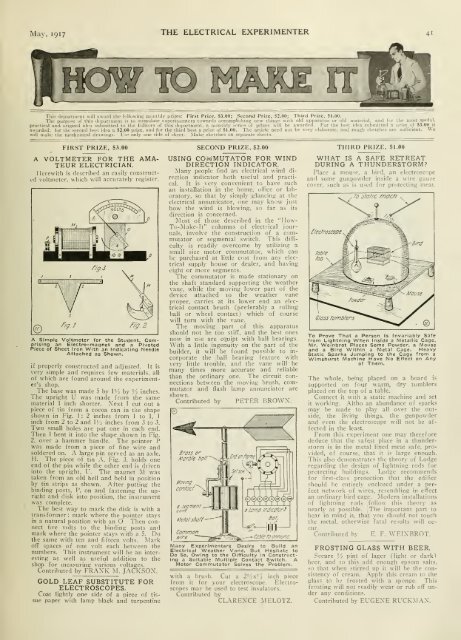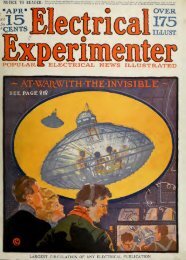The Electrical experimenter
The Electrical experimenter
The Electrical experimenter
Create successful ePaper yourself
Turn your PDF publications into a flip-book with our unique Google optimized e-Paper software.
May, 1917 THE ELECTRICAL EXPERIMENTER 41<br />
Q)W<br />
This depariment will iiward the following monthly prizes: First Prize, $i.OO; Second Prize. $2.00; Third Prize, $1.00.<br />
<strong>The</strong> purpose of this department is to stimulate <strong>experimenter</strong>s towards accompiisbing new things with old apparatus or old material, and for the meet useful,<br />
practical and orisinal idea submitted to the Editors of this department, a monthly series of prizes will be awarded. For the best idea submitted a prize of $3.00 is<br />
awarded; for the second best idea a $2.00 prize, and for the third best a prize of $1.00. <strong>The</strong> article need not be very elaborate, and rough sketches are sufficient. We<br />
will make the mechanical drawings. Use only one side of sheet. Make sketches on separate sheets.<br />
FIRST PRIZE, $3.00<br />
A VOLTMETER FOR THE AMA-<br />
TEUR ELECTRICIAN.<br />
Herewith is described an easily constructed<br />
voltmeter, vvliicli will accurately register.<br />
A Simple Voltmeter for the Student, Comprising<br />
an Electro-magnet and a Pivoted<br />
Piece of Sheet Iron With an Indicating Needle<br />
Attached as Shown.<br />
if properly constructed and adjusted. It is<br />
very simple and requires few materials, all<br />
of which arc found around the <strong>experimenter</strong>'s<br />
shop.<br />
<strong>The</strong> base was made 5 by \'/> by '/> inches.<br />
<strong>The</strong> upright U was made from the same<br />
material 1 inch shorter. Xext I cut out a<br />
piece of tin from a cocoa can in the shape<br />
shown in F'ig. 1 : 2 inches from 1 to 1, 1<br />
inch from 2 to 2 and 1 ' _, inches from 3 to 3.<br />
Two small holes are put one in each end.<br />
<strong>The</strong>n 1 bent it into the shape shown in Fig.<br />
2. over a hammer handle. <strong>The</strong> pointer P<br />
was made from a piece of fine wire and<br />
soldered on. .V large pin served as an axle,<br />
H. <strong>The</strong> piece of tin .A, Fig. 3. holds one<br />
end of the pin while the other end is driven<br />
into the upright, L'. <strong>The</strong> magnet M was<br />
taken from an old bell and hehl in position<br />
by tin strips as shown. After putting the<br />
binding posts, P, on and fastening the upright<br />
and- disk into position, the instrument<br />
was complete.<br />
<strong>The</strong> best way to mark the disk is with a<br />
transformer: mark where the pointer stays<br />
in a natural position with an O <strong>The</strong>n connect<br />
five volts to the binding posts and<br />
mark where the pointer stays with a 5. Do<br />
the same with ten and fifteen volts. Mark<br />
oflf spaces of one volt each between the<br />
numbers. This instrument will be an interesting<br />
as well as useful addition to the<br />
shop for measuring various voltages.<br />
Contributed by FRAX'K M. JACKSON'.<br />
GOLD LEAF SUBSTITUTE FOR<br />
ELECTROSCOPES.<br />
Coat lightly one side of a piece of tissue<br />
paper with lamp black and turpentine<br />
SECOND PRIZE, $2.00<br />
USING COMMUTATOR FOR WIND<br />
DIRECTION INDICATOR.<br />
Many people find an electrical wind direction<br />
indicator both useful and practical.<br />
It is very convenient to have such<br />
an installation in the home, office or laboratory,<br />
so that by simply glancin.g at the<br />
electrical annunicator, one may know just<br />
how the wind is blowing, so far as its<br />
direction is concerned.<br />
Most of those described in the "How-<br />
To-Make-It" columns of electrical journals,<br />
involve the construction of a commutator<br />
or segmental switch. This difficulty<br />
is readily overcome by utilizing a<br />
small size motor commutator, which can<br />
be purchased at little cost from any electrical<br />
supply house or dealer, and having<br />
eight or more segments.<br />
<strong>The</strong> commutator is made stationary on<br />
the shaft standard supporting the weather<br />
vane, while the moving lower part of the<br />
device attached to the weather vane<br />
proper, carries at its lower end an electrical<br />
contact brush (preferably a rolling<br />
ball or wheel contact) which of course<br />
will turn with the vane.<br />
<strong>The</strong> moving part of this apparatus<br />
should not be too stiff, and the best ones<br />
now in use are equipt with ball bearings.<br />
With a little ingenuity on the part of tlie<br />
builder, it will be found possible to incorporate<br />
the ball bearing feature with<br />
very little trouble,<br />
many times more<br />
and the<br />
accurate<br />
vane<br />
and<br />
will ' be<br />
reliable<br />
than the ordinary one. <strong>The</strong> circuit connections<br />
between the moving brush, commutator<br />
and flash lamp annunciator are<br />
shown.<br />
Contributed by PETER BROWX.<br />
Ci7t>/e fO unni/nc<br />
Many Experimenters Desire to Build an<br />
<strong>Electrical</strong> Weather Vane, But Hesitate to<br />
Do So, Owing to the Difficitlty in Constructing<br />
a Suitable Multiple Contact Switch. A<br />
Motor Commutator Solves the Problem.<br />
with a brush. Cut a 2'2x'4 inch piece<br />
from it for your electroscope. Electroscopes<br />
may be used to test insulators.<br />
Contributed bv<br />
"CLARENCE MELOTZ.<br />
THIRD PRIZE, $1.00<br />
WHAT IS A SAFE RETREAT<br />
DURING A THUNDERSTORM?<br />
Place a mouse, a bird, an electroscope<br />
and some gunpowder inside a wire gauze<br />
cover, such as is used for protecting meat.<br />
f/edroscope<br />
Glass Wmb/ers<br />
To dtafic macf? -<br />
To Prove That a Person Is Invariably Safe<br />
from Lightning When Inside a Metallic Cage,<br />
Mr. Weinbrot Places Some Powder, a Mouse<br />
and a Bird Within a Metal Cage. Heavy<br />
Static Sparks Jumping to the Cage from a<br />
Wimshurst Machine Have No Effect on Any<br />
of <strong>The</strong>m.<br />
<strong>The</strong> whole, being placed on a board is<br />
supported on four warm, dry tumblers<br />
placed on the top of a table.<br />
Connect it with a static machine and set<br />
it working. Altho an abundance of sparks<br />
may be made to play all over the outside,<br />
the living things, the gunpowder<br />
and even the electroscope will not be affected<br />
in the least.<br />
From this experiment one may therefore<br />
deduce that the safest place in a thnnderstorm<br />
is in the metal lined meat safe, provided,<br />
of course, that it is large enough.<br />
This also demonstrates the theory of Lodge<br />
regarding the design of lightning rods for<br />
protecting buildings. Lodge recommends<br />
for first-class protection that the edifice<br />
should be entirely enclosed under a perfect<br />
network of wires, resembling in effect<br />
an ordinary bird cage. Modem installations<br />
of lightning rods follow this theory as<br />
nearly as possible. <strong>The</strong> important part to<br />
bear in mind is, that you should not touch<br />
the metal, otherwise fatal results will occur.<br />
Contributed by E. F. WEINBROT.<br />
FROSTING GLASS WITH BEER.<br />
.^ccure<br />
' .' pint of lager (light or dark)<br />
beer, and to this add enough epsom salts,<br />
so that when stirred up it will be the consistency<br />
of cream. .-Xpply this cream to the<br />
glass to be frosted with a sponge. This<br />
frosting will not readily wear or rub off under<br />
any conditions.<br />
Contributed by EUGENE RUCKMAN.




